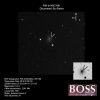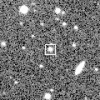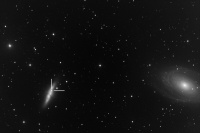Supernovae Catalog
A supernova is a stellar explosion caused when the mass of a star's core exceeds the sustainable limit or when nuclear fusion produces more energy than the star can contain. The explosion emits massive amounts of energy. Supernovae are classified as cataclysmic variables, the majority of which are close binary systems. Supernovae show sudden, dramatic, and final magnitude increases of 20 magnitudes or more, compared to a regular nova, which typically brighten 7 to 16 magnitudes.
The data collected below comes from multiple sources, although primary catalog is compiled leveraging IAU Central Bureau for Astronomical Telegrams. The Central Bureau for Astronomical Telegrams (CBAT) operates under the auspices of Commission 6 of the International Astronomical Union (IAU) and is a nonprofit organization, with principal funding coming from subscriptions to the various services offered by the Bureau, and (during 2008-2010) also from the U.S. National Science Foundation.
I'm cataloging these primarily as a personal education tool, and to begin tracking supernova I have photographed.
SN 2014J
SN 2014J is a type Ia supernova in Messier 82, and was discovered in mid-January 2014. It is the closest type-Ia supernova discovered in the past 42 years. The last supernova that was unambiguously closer to Earth than SN 2014J was SN 2004dj, which was of Type II-P supernova. This supernova occurred in the galaxy NGC 2403. Due to the brightneszs of this supernova, many automated search programs which search for supernovas actually ignored this one (assuming error). It was discovered accidentally during an undergraduate teaching session at University of London Observatory. I shot this on January 29th, two days before SN2014J stopped brightening, which reached its peak brightness at magnitude 10.5.
Recent Supernovae
| Date | SN | Photo | Host Galaxy | Date-SN | R.A. | Decl. | Offset | Mag. | Disc | . Ref. | SN Position | Posn | . Ref. | Type | SN | Discoverer(s) | Note | |
|---|---|---|---|---|---|---|---|---|---|---|---|---|---|---|---|---|---|---|
| 5/7/2014 | 2014ba | 
|
NGC 7410 | 2014 05 07 | 22 55.0 | -39 40 | 12E 6N | 14.7 | CBET | 3873 | 22 55 01.97 -39 39 34.5 | CBET | 3873 | Ia-p | 2014ba | Parker | ||
| 4/30/2014 | 2014az | 
|
NGC 7691 | 2014 04 30 | 23 32.4 | +15 51 | 22W 18N | 16.3 | CBET | 3872 | 23 32 22.84 +15 51 10.6 | CBET | 3872 | IIp | 2014az | Parker | ||
| 5/4/2014 | 2014ay | 
|
UGC 11037 | 2014 05 04 | 17 55.1 | +18 15 | 16.7 | CBET | 3871 | 17 55 05.43 +18 15 26.4 | CBET | 3871 | II | 2014ay | Holoien et al. (All-Sky Automated Survey for SuperNovae) | |||
| 5/3/2014 | 2014ax | 
|
UGC 10318 | 2014 05 03 | 16 16.3 | +64 06 | 2E 3S | 17.6 | CBET | 3867 | 16 16 18.16 +64 06 06.3 | CBET | 3867 | IIP | 2014ax | Boles | ||
| 4/25/2014 | 2014aw | 
|
Anon. | 2014 04 25 | 16 10.4 | +47 05 | 16.5 | CBET | 3866 | 16 10 23.61 +47 04 40.3 | CBET | 3866 | Ia | 2014aw | Drake et al. (Catalina Real-time Transient Survey) |

